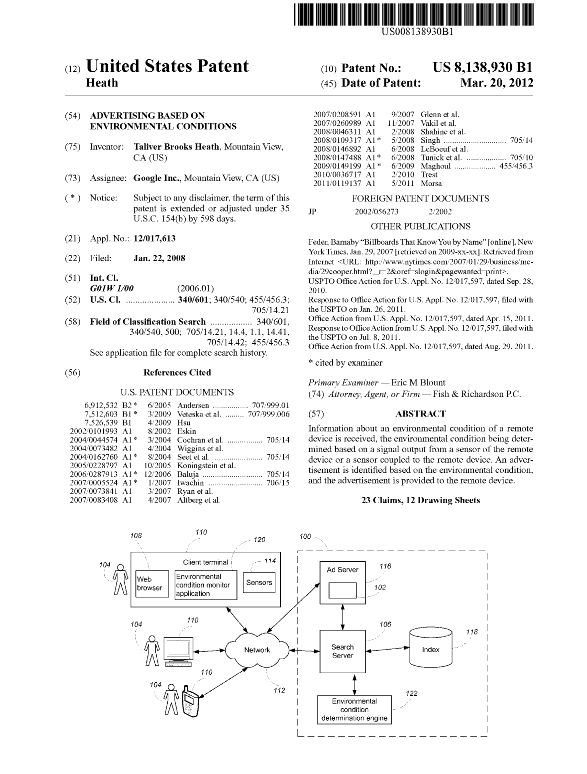ADVERTISING BASED ON ENVIRONMENTAL CONDITIONS
- 24 pages
- March 20, 2012
On-line advertisements allow advertisers to reach a wide range of viewers through the Internet. The selection of advertisements for display, such as with search results and other information, and the ordering of those advertisements, may be achieved by various techniques. In one example, an initial determination is made to identify all advertisements that are a match or near match for the applied search terms or other query items or information. The match may be made, for example, between one or more words in a query, and key words identified by an advertiser and associated with a particular advertisement or group of advertisements, such as a campaign. For example, a company selling fishing tackle may have a line of large lures, and may thus identify terms such as “lunker,” “sturgeon,” and “muskie fever” as keywords to associate with their advertisements for such large lures. Those advertisements may then be considered by the system for display when a search results are displayed to a user who enters such terms. The comparison may also be made between a search or query, and the text in an advertisement or the text in a target of a hyperlink in an advertisement, or to a combination of keywords, target text, and advertisement text, among other possible techniques. For example, the system may effectively select terms from an advertisement as key words so that the advertisement is selected for possible display when a search or other user action associated with the key words is submitted. An advertisement may be selected for possible display if there is a “near” match also, for example, if a query includes terms that are known synonyms or mistypings/misspellings of the key word terms for an advertisement.
This document describes a system for allowing advertisers to target on-line advertisements based on environmental factors of end users. When determining what ads to serve to end users, the environmental factors can be used independently or in combination with matching of keywords associated with the advertisements and keywords in user search queries. A web browser or search engine located at the user’s site may obtain information on the environment (e.g., temperature, humidity, light, sound, air composition) from sensors. Advertisers may specify that the ads are shown to users whose environmental conditions meet certain criteria. For example, advertisements for air conditioners can be sent to users located at regions having temperatures above a first threshold, while advertisements for winter overcoats can be sent to users located at regions having temperatures below a second threshold.
…
Implementations may include one or more of the following features. The sensor can include an environmental sensor that provides information about the environmental condition. The sensor can be part of or coupled to a machine used by the user for accessing the network. At the server, the advertisement can be identified from among a plurality of advertisements by matching an environmental condition associated with the advertisement with the environmental condition of the user. The environmental condition can include at least one of temperature, humidity, sound, light, air composition, location, and speed of movement. The environmental condition can include at least one of soil, crop, or livestock conditions. The advertisement can be associated with a predetermined temperature condition, and the server can provide the advertisement to the user when the temperature at the user’s site or at a geographical location of the user meets the predetermined temperature condition. The advertisement can be associated with a predetermined sound level condition, and the server provides the advertisement to the user when the ambient sound level at the user’s site meets the predetermined sound level condition.

